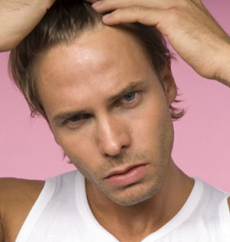DEALING WITH MALE PATTERN HAIR LOSS
Posted by Manny Y on 8th Apr 2015
So one day after a family reunion, you find most of your uncles either have an overly exceeding hair line or totally bald. After noticing this you ask yourself: Can I end up being bald too?

Sadly, the answer is yes. A family history of hair loss is a strong indicator for condition called androgenetic alopecia or commonly known as male pattern hair loss. This is actually the most common type of hair loss affecting most men around the age of 30, and hair loss cases increase with age.
So how exactly does Androgenetic alopecia cause hair loss?
The gene responsible for androgenetic alopecia causes the hair follicles in the scalp to become sensitive to a substance normally made by the body called dihydrotestosterone or DHT. This is actually a very important male hormone and is accountable for various sexual functions.
What DHT does to the hair is still unknown but it is considered that the hormone causes the skin of the scalp to stiffen or firm up, this causes the blood vessels , therefore, decreasing the blood supply to the scalp and hair follicles. Ever noticed an adult scalp is firmer than a child’s scalp?
Decrease in blood supply means lower oxygenation and nutrient delivery to the hair follicles and this is disastrous to the production of hair. The cells found at the bottom of the hair follicles are thought to be among the fastest growing cells in the body, for it to generate about half an inch of hair a month, it needs a constant supply of nutrients. If the nutrients are cut off or lacking, the hair follicles starts to shrink or atrophy, no longer able to produce strong healthy hair strands. But the hair follicles never die out, they’re still there on the scalp and still producing hair, super fine transparent hair called fuzz or peach hair.
Considering that the hair follicles are still there, they can be stimulated to grow back hair with hair loss treatments. There are a lot of hair loss treatment products available on the market today, but be aware that some of these products can cause all sorts of unwanted side effects. To be safe, it’s best to use topical shampoos and tonics to safely encourage new hair growth.

